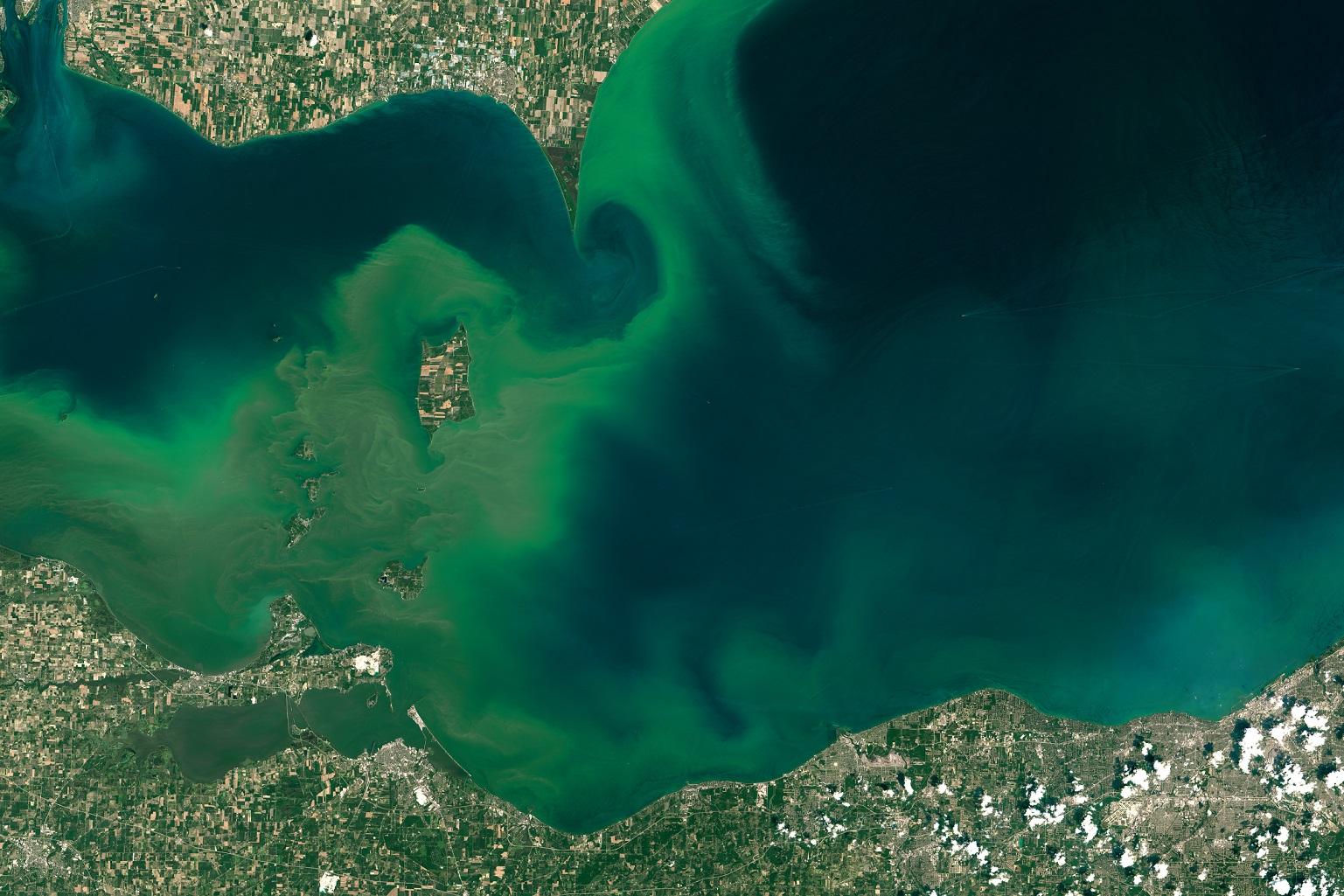
Cyanobacteria in freshwater

Cyanobacteria, commonly referred to as blue-green algae, are naturally occurring photosynthetic bacteria found in lakes, rivers, brackish, and marine waters. Cyanobacteria can pose a hazard to people or animals when there is a rapid propagation of cyanobacterial cells, forming a bloom in recreational waters or drinking water sources. The look and colour of blooms of different species varies and can have the appearance of water discolouration, spilled paint, grass clippings, or scum, and can range from bright green to brownish, reddish, or pink. Blooms are often seen at the water surface, but cyanobacteria can also form subsurface benthic mats, attached to substrates such as rocks or gravel in riverbeds or shallow lakes.
In freshwater systems blooms can be driven by an influx or resuspension of nutrients (N&P), warm water temperature (> 20°C), and are more common in stagnant waters with low turbulence or flushing. Blooms are more common in eutrophic versus oligotrophic lakes and, in Canada, occur most often during summer to early fall (e.g., May-Oct), but can occur all year round. Several factors could affect the frequency, duration, and distribution of blooms in some waterbodies in the future, as well as the dominant species of cyanobacteria present. These factors include land use changes and pollution, which impact nutrient loading to water ways, and climate change, which impacts warming and hydrological conditions (Pick 2016; Chorus et al., 2021; Silvarajah et al., 2021; Bonilla et al., 2023).
Some cyanobacterial blooms, which can also be referred to as harmful algal blooms (HABs), may be comprised of species that can produce cyanotoxins. Cyanotoxins can include hepatotoxins (liver toxins such as microcystins (MC), cylindrospermopsin, or nodularin) and neurotoxins (e.g., anatoxins, saxitoxins, or β-methylamino-l-alanine (BMAA)). Lipopolysaccharides, also referred to as endotoxins, on the surface of some cyanobacterial cells can cause a range of health effects from skin irritation to gastrointestinal or allergic reactions. Exposure to various cyanotoxins through skin contact, ingestion of contaminated water or food, or inhalation of aerosolized cyanobacteria or toxins can cause acute symptoms ranging from minor skin irritation, vomiting, diarrhea, rash, fever, and headache to more serious illness or even death in humans and animals (Svirčev et al., 2017). Less is known about the effects of chronic exposure to low doses of cyanotoxins, but possible chronic health effects include carcinogenic effects, neurological conditions, and liver damage. One cyanotoxin, microcystin-LR (MC-LR), has been classified as Group 2B, possibly carcinogenic to humans, after chronic exposure (IARC 2010).
The resources presented below are intended to assist public health practitioners to:
- Be aware of the health effects that may arise from exposure to cyanobacteria and cyanotoxins;
- Understand what is known about exposure to cyanotoxins in different media (drinking water, recreational waters, food, air);
- Identify approaches to monitoring, managing, and preventing exposure to blooms in both drinking and recreational waters.
Health effects of exposure to cyanobacteria and their cyanotoxins
- Harmful algal bloom-associated illnesses. Information for specific groups (US CDC, 2023)
This website provides information on HABs and the illnesses they cause, with specific guidance for pet or livestock owners, veterinarians, healthcare providers and poison centre professionals.
- Anatoxins from benthic cyanobacteria responsible for dog mortalities in New Brunswick, Canada (McCarron et al., 2023)
This article reports on an investigation of three dog deaths in the Wolastoq (Saint John River) New Brunswick and the role of toxin-producing benthic cyanobacteria in their death.
- As we drink and breathe: adverse health effects of microcystins and other harmful algal bloom toxins in the liver, gut, lungs and beyond (Lad et al., 2022)
This review paper examines the evidence on chronic, low-dose exposure to cyanotoxins, especially for persons with pre-existing liver or gastrointestinal disease.
- Toxic cyanobacteria in water – second edition (Chorus and Welker, 2021)
This guidance document published by the World Health Organization, summarizes the current state of knowledge on the occurrence of cyanobacteria and cyanotoxins, their impacts on health through water-related exposures, and advice on hazard identification and management of risks.
- Cyanotoxins: producing organisms, occurrence, toxicity, mechanism of action and human health toxicological risk evaluation (Buratti et al., 2017)
This review article synthesizes data on the properties and occurrence of cyanotoxins (microcystins, nodularins, cylindrospermopsin and neurotoxins) in various media and their toxicological profiles.
- Acute animal and human poisonings from cyanotoxin exposure – a review of the literature (Wood, 2016)
This review article provides an account of reported incidents of mortality and morbidity from 1800 to 2010 in humans and animals, with result by country and exposure (e.g. recreation, drinking water).
- Prospective study of acute health effects in relation to exposure to cyanobacteria (Lévesque et al., 2014)
This article provides one of the few Canadian studies that has investigated the incidence of symptoms among residents exposed to bloom-affected lakes via recreational or drinking water.
Exposure: Drinking and recreational water sources
- Recreational water quality and health: cyanobacteria and their toxins (Health Canada, 2023)
This website provides an overview of exposure risks to cyanobacteria in recreational waters, the symptoms that may occur following exposure, and risk reducing measures for recreational waters.
- Deep cyanobacteria layers: an overlooked aspect of managing risks of cyanobacteria (Erratt et al., 2022)
This case-study of an Ontario lake examines the risks to drinking water supply from cyanotoxin production at different depths in a water column, specifically in a deep cyanobacteria layer.
- Quantitative screening for cyanotoxins in soil and groundwater of agricultural watersheds in Quebec, Canada (Zhang et al., 2021)
This article reports on a study of well water in Quebec, finding possible transfer of cyanotoxins from surface water to groundwater through hydrologic processes, resulting in well water contamination.
- Cyanobacteria and drinking water: occurrence, risks, management and knowledge gaps for public health (O’Keeffe, 2019)
This NCCEH evidence review provides a scan of the occurrence of cyanobacterial blooms in Canada, and their impacts on drinking water. See accompanying webinar on this from the NCCEH, and managing cyanobacteria risks in small water systems from the Walkerton Clean Water Centre.
Exposure: Food (fish, irrigated crops, and dietary supplements)
Fish
- Cyanotoxins accumulate in Lake St. Clair fish yet their fillets are safe to eat (Shahmohamadloo et al., 2023)
This article reports on analysis of microcystins in bass, pike, walleye and perch from Lake St. Clair, detecting toxin at significant levels in some fish livers, and estimating elimination rates.
- Fish tissue accumulation and proteomic response to microcystins is species-dependent (Shahmohamadloo et al., 2022)
This article reports on a study that measured microcystins in liver and muscle of rainbow trout and lake trout, finding greater accumulation in the liver than muscle.
- A global analysis of the relationship between concentrations of microcystins in water and fish (Flores et al., 2018)
This review article synthesizes findings from studies measuring microcystin concentrations in water and fish, finding a positive relationship between levels detected in water and in fish tissues. The study also highlights the type of fish with highest tissue MC.
- Detection of freshwater cyanotoxins and measurement of masked microcystins in tilapia from Southeast Asian aquaculture farms (Greer et al. 2017)
This research article reports on testing of muscle, liver and egg tissue of tilapia from aquaculture farms in Southeast Asia for microcystins and cylindrospermopsin.
Crops
- Cyanotoxins uptake and accumulation in crops: Phytotoxicity and implications on human health (Weralupitiya et al. 2022)
This review article provides an overview of the accumulation of cyanotoxins (microcystins, cylindrospermopsins, BMAA, and anatoxin-a) in crops and the potential health implications.
- Transfer of a cyanobacterial neurotoxin, beta-methylamino-L-alanine from soil to crop and its bioaccumulation in Chinese cabbage (Li et al., 2019)
This research article reports on uptake of cyanotoxin BMAA in Chinese cabbage from soil, identifying accumulation into the edible portions at levels higher than in the initial soil.
- High ecological and human health risks from microcystins in vegetable fields in southern China (Xiang et al., 2019)
This article reports on detection of MC in vegetables, soils, and irrigation water from a region affected by cyanoblooms, finding some leafy vegetables such as celery to accumulate higher levels of toxins, due to higher levels of irrigation water used than fruit or root vegetables.
- Irrigating food crops with water containing cyanobacteria blooms (Miller et al., 2017)
This NCCEH field inquiry reviews the literature on accumulation of cyanotoxins in crops irrigated with cyanotoxin-contaminated water
Supplements
- Finished product specifications form user guide (Health Canada, 2022)
This guidance document sets out the Health Canada ingredient-specific limits parameters in natural health products, including cyanotoxins in cyanobacterial materials (0.02 µg MC-LR/kg bw/d).
- Production of the neurotoxin beta-N-methylamino-l-alanine may be triggered by agricultural nutrients: an emerging public health issue (Zhang and Whalen, 2020)
This article examines human exposure pathways to sources of BMAA, and summarizes levels detected in various dietary supplements and in water bodies used for recreation and drinking water.
- Microcystin toxins at potentially hazardous levels in algal dietary supplements revealed by a combination of bioassay, immunoassay, and mass spectrometric methods (Miller et al., 2020).
This research article reports on the testing for total microcystins in 18 algal products such as dietary supplements made with algae harvested from outdoor environments.
- Detection of cyanotoxins in algae dietary supplements (Roy-Lachapelle et al., 2017)
This research article reports on the testing of several cyanotoxins in dietary supplements, detecting microcystins, anatoxin-A and its transformation products, and BMAA in some products.
Exposure: Inhalation
- Harmful algal bloom aerosols and human health (Lim et al., 2023)
This review article synthesizes current knowledge on the risks to health from inhalation of aerosols from HABs and identifies key research gaps.
- Harmful cyanobacterial aerosolization dynamics in the airshed of a eutrophic estuary (Plaas et al., 2022)
This article reports on a study to measure cyanobacteria and cyanotoxins in aerosols near a eutrophic estuary, finding an association between HABs and elevated particulate matter (PM2.5).
- Toxic cyanobacteria: a growing threat to water and air quality (Plaas and Paerl, 2020)
This review article synthesizes information on cyanotoxin fate in the environment including in spray aerosols, and the adverse health outcomes associated with inhalation exposure to cyanotoxins.
- Exposure to microcystin among coastal residents during a cyanobacteria bloom in Florida (Shaefer et al., 2020)
This study investigated exposure to MC among residents living, working or recreating on, or near, Lake Okeechobee in Florida by testing MC concentrations in nasal swabs.
Monitoring and managing cyanobacterial blooms: Guidelines, response, and treatment approaches
Monitoring for cyanobacterial blooms
- Cyanobacterial algal bloom monitoring: molecular methods and technologies for freshwater ecosystems (Saleem et al., 2023)
This article provides a review of technologies for monitoring cyanobacteria and cyanotoxins, including sensitivity, advantages and limitations of various methods.
- Algae watch (Government of BC, 2023)
This website provides educational citizen science resources for recognizing algal blooms, and reporting observations of blooms in BC, which are posted in an online observation map.
- State of knowledge on early warning tools for cyanobacteria detection (Almuhtaram et al., 2021)
This review article synthesizes current knowledge on monitoring tools for cyanobacterial blooms including conventional tools and emerging techniques (e.g., genomic sequencing, photonic systems, biosensors, drones, machine learning).
- Monitoring, managing, and communicating risk of harmful algal blooms (HABs) in recreational resources across Canada (Rashidi et al., 2021)
This article presents an environmental scan of Canadian provincial and territorial strategies and protocols for monitoring, managing and communicating on risks of HABs in recreational waters.
Guidelines: Drinking water
- Drinking water health advisory documents for cyanobacterial toxins (US EPA, 2023)
This website provides the supporting information for establishing drinking water health advisories for cyanotoxins in drinking water in the US including anatoxin-A, cylindrospermopsin, and microcystins.
- Guidelines for drinking-water quality: fourth edition (World Health Organization, 2022)
This guidance document provides an overview of the WHO guidelines for safe drinking water, including for cyanobacteria and cyanotoxins, with a simplified alert level framework for early-warning and to guide short-term management responses.
- Guidelines for Canadian drinking water quality: guideline technical document – cyanobacterial toxins(Health Canada 2018)
This guideline sets out the rationale for the Canadian maximum acceptable concentration of total microcystins in drinking water, with advice on implementing the guideline responding to blooms.
Guidelines: Recreational water
- Guidelines for Canadian recreational water quality – cyanobacteria and their toxins (Health Canada, 2022).
This guidance document sets out the guideline value for total microcystins (10 µg/L) and other indicators of the potential presence of cyanotoxins in Canadian recreational waters.
- WHO guidelines on recreational water quality: volume 1: coastal and fresh waters (WHO, 2021)
This guidance document sets out the WHO recommended approaches to managing health risks in recreational waters. Section 5 sets out information about HABs including indicators and guideline values and an alert level framework for responding to HABs.
- Recreational water quality criteria or swimming advisories for cyanotoxins (US EPA, 2019)
This website provides information on the US EPA recommended safe concentrations of microcystins and cylindrospermopsins in recreational waters for swimmers or other recreational water users.
Responding to and preventing bloom events
- Waterborne disease outbreak investigation toolkit (US CDC, 2023)
This toolkit contains information on conducting waterborne disease outbreak investigations, and includes a detailed appendix on investigating harmful algal blooms (p. 30-42).
- Freshwater science research (Ohio Sea Grant and Stone Lab, 2022)
These webinar recordings present research on treatment technologies for cyanotoxins in drinking water, including presentations on activated carbon, reverse osmosis and biological treatment.
- US EPA resources (2022-2023)
These quick reference guides summarize treatment technologies for managing HABs in drinking water and recreational waters, and their relative effectiveness and limitations- Summary of cyanotoxins treatment in drinking water (US EPA 2022)
- Control measures for cyanobacterial HABs in surface water (US EPA, 2023)
- Preventive measures for cyanobacterial HABs in surface water (US EPA, 2023)
- Strategies for preventing and managing harmful cyanobacterial blooms (HCB-1, planktonic blooms) and Benthic harmful cyanobacterial blooms (HCB-2 benthic blooms) (Interstate Technology & Regulatory Council, 2020 & 2022)
These guidance documents provide a detailed overview of cyanobacteria and their ecology, cyanotoxins and their health effects, monitoring tools, approaches to communication and response.
- A critical review on operation and performance of source water control strategies for cyanobacterial blooms (Kibuye et al., 2021)
This review article outlines physical (e.g., aeration, dredging, sonication) and biological control strategies for cyanobacteria in freshwaters including the strengths and limitations of approaches.
- Cyanobacterial harmful algal blooms in aquatic ecosystems: a comprehensive outlook on current and emerging mitigation and control approaches (Sukenik and Kaplin, 2021)
This review article examines emerging mitigation approaches and in-lake treatment methods as well as drinking water treatment applications.
- Decision protocols for cyanobacterial toxins in BC drinking water and recreational water(Government of British Columbia, 2018)
This decision support document provides guidance on evaluating and managing cyanobacterial blooms in BC, with decision trees for responding to bloom events in drinking or recreational waters.
See other NCCEH water-related subject guides:








